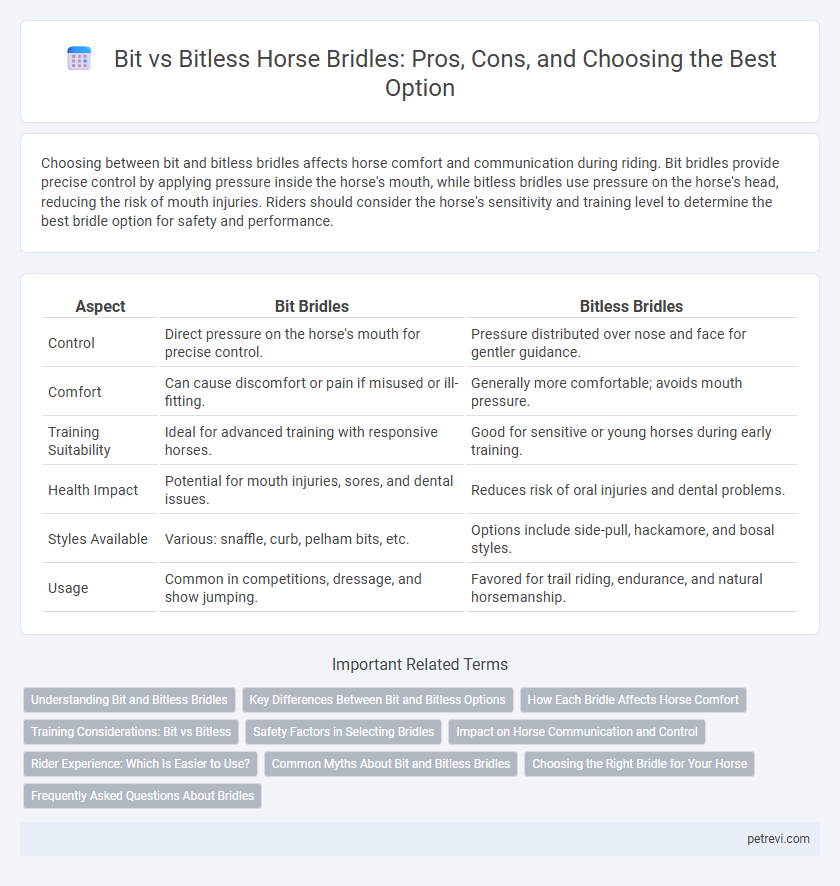Choosing between bit and bitless bridles affects horse comfort and communication during riding. Bit bridles provide precise control by applying pressure inside the horse's mouth, while bitless bridles use pressure on the horse's head, reducing the risk of mouth injuries. Riders should consider the horse's sensitivity and training level to determine the best bridle option for safety and performance.
Table of Comparison
| Aspect | Bit Bridles | Bitless Bridles |
|---|---|---|
| Control | Direct pressure on the horse's mouth for precise control. | Pressure distributed over nose and face for gentler guidance. |
| Comfort | Can cause discomfort or pain if misused or ill-fitting. | Generally more comfortable; avoids mouth pressure. |
| Training Suitability | Ideal for advanced training with responsive horses. | Good for sensitive or young horses during early training. |
| Health Impact | Potential for mouth injuries, sores, and dental issues. | Reduces risk of oral injuries and dental problems. |
| Styles Available | Various: snaffle, curb, pelham bits, etc. | Options include side-pull, hackamore, and bosal styles. |
| Usage | Common in competitions, dressage, and show jumping. | Favored for trail riding, endurance, and natural horsemanship. |
Understanding Bit and Bitless Bridles
Bit bridles use a metal piece placed in the horse's mouth to enhance rider control, affecting communication and responsiveness. Bitless bridles rely on pressure points on the horse's head, offering a gentler alternative for horses with mouth sensitivity or behavioral issues. Understanding the biomechanical impact of each bridle type aids in selecting the right equipment for the horse's comfort and training goals.
Key Differences Between Bit and Bitless Options
Bit bridles apply direct pressure to a horse's mouth, providing precise control and communication through the reins, while bitless bridles distribute pressure across the horse's nose, jaw, and poll, enhancing comfort for sensitive horses. Bit options often allow more refined signals but may cause discomfort or injury if misused, whereas bitless alternatives reduce mouth sensitivity risks and are preferred for horses with dental issues or behavioral problems related to the bit. Selecting between bit and bitless bridles depends on the horse's training level, mouth health, and rider's control requirements.
How Each Bridle Affects Horse Comfort
Bit bridles apply direct pressure on the horse's mouth, which can cause discomfort or pain if improperly fitted or used, potentially leading to resistance or behavioral issues. Bitless bridles distribute pressure more evenly across the horse's face and poll, often enhancing comfort by avoiding sensitive areas in the mouth. Comfort levels depend on the horse's sensitivity, training, and the correct adjustment of either bridle type to ensure gentle communication between rider and horse.
Training Considerations: Bit vs Bitless
Training considerations for horse bridles involve the choice between bit and bitless options, each impacting communication and control differently. Bit bridles offer precise signals through direct pressure on the horse's mouth, ideal for refined cues in advanced training, while bitless bridles rely on pressure points on the nose and jaw, promoting a gentler approach with less risk of oral discomfort. Selection depends on the horse's sensitivity, training goals, and rider experience, with bitless bridles often preferred for young, sensitive, or rehabilitating horses to foster trust and responsiveness.
Safety Factors in Selecting Bridles
Selecting between bit and bitless bridles significantly impacts equine safety, with bitless options reducing the risk of mouth injuries and discomfort. Bitless bridles distribute pressure across the horse's head, minimizing airway obstruction and soft tissue damage common with bits. Safety considerations prioritize the horse's comfort and avoidance of control loss, especially for sensitive or young horses.
Impact on Horse Communication and Control
Bit bridles enable precise communication through direct pressure on the horse's mouth, allowing riders to deliver clear, instantaneous signals for control and direction. Bitless bridles promote gentler control by applying pressure on the horse's nose and poll, often reducing oral discomfort and enhancing trust during riding. Each bridle type affects the horse's responsiveness differently, impacting training outcomes and the overall riding experience.
Rider Experience: Which Is Easier to Use?
Bitless bridles offer a gentler communication method, reducing discomfort for horses and making them easier to handle for novice riders. Traditional bit bridges provide precise control but may require more skill to use effectively without causing distress. Many riders find bitless options promote a more relaxed and responsive partnership, especially in trail riding and therapeutic settings.
Common Myths About Bit and Bitless Bridles
Common myths suggest bit bridles cause pain, but when used properly, bits communicate subtle cues without discomfort. Bitless bridles are often perceived as safer, yet their effectiveness depends on rider skill and horse sensitivity, debunking the idea that they are universally gentler. Both bit and bitless bridles require proper fitting and training to ensure horse comfort and responsive control.
Choosing the Right Bridle for Your Horse
Selecting the right bridle for your horse involves understanding the differences between bit and bitless options, as each impacts control and comfort differently. Bit bridles offer precise rein cues and are often preferred for advanced training, while bitless bridles reduce pressure on the horse's mouth, enhancing comfort and minimizing resistance. Assessing your horse's behavior, mouth sensitivity, and riding discipline helps determine the optimal bridle choice for improved communication and performance.
Frequently Asked Questions About Bridles
Horse bridles come in two main types: bit and bitless, each influencing communication and control differently. Bit bridles use a metal mouthpiece to enhance rider signals, while bitless bridles rely on pressure applied to the horse's head, offering a gentler alternative. Riders often ask about comfort, control effectiveness, and suitability for various disciplines when choosing between bit and bitless bridles.
Bit vs Bitless for Horse Bridles Infographic

 petrevi.com
petrevi.com